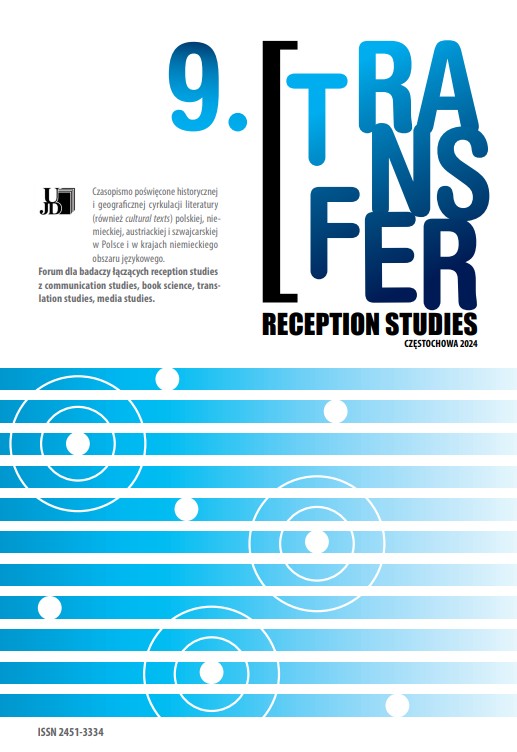Digital Narrator as a Game Master. The Case of Baldur’s Gate III
Abstract
This article is a preliminary exploratory analysis of the narrator in Baldur’s Gate III seen as a digital simulation of an analogue game master (GM). As the reception of Baldur’s Gate series has always been closely linked to its analogue predecessor, Dungeons & Dragons, the main context of the analysis is theoretical reflections concerning tabletop role-playing games (TRPG), especially in relation to digital ones. The analysis covers not only a close reading of some of the in-game utterances, but also the commentary of Amelia Tyler, the actress lending her voice to the narrator. The author argues that while all installments of the series attempted to re-create certain experiences characteristic of TRPG sessions through the digital medium, one of key differences between Baldur’s Gate III and its predecessors is that it features a complex, voiced narration, designed according to real-life GMs.
Keywords:
role-playing games, Baldur’s Gate , narratorReferences
References
Aarseth, Espen. Cybertext. Perspectives on Ergodic Literature. Baltimore and London: The Johns Hopkins University Press, 1997. Google Scholar
Bell, Alice, and Astrid Ensslin. “«I know what it was. You know what it was»: Second-Person Narrative in Hypertext Fiction.” Narrative 3, vol. 19 (October 2011): 311‒329. Google Scholar
Collins, Karen. Game Sound. An Introduction to the History, Theory and Practice of Video Game Music and Sound Design. Cambridge and London: The MIT Press, 2008. Google Scholar
Dungeons & Dragons. “An Astarion and Karlach Adventure: Love is Google Scholar
a Legendary Action | D&D Baldur's Gate.” August 6, 2024, 2:00:45. https://www.youtube.com/watch?v=Cn7XLBykzEU. Google Scholar
Garda, Maria B. Interaktywne fantasy. Gatunek w grach cyfrowych. Łódź: Wydawnictwo Uniwersytetu Łódzkiego, 2016. Google Scholar
Grouling Cover, Jennifer. The Creation of Narrative in Tabletop Role-Playing Games. Jefferson and London: McFarland & Company, 2010. Google Scholar
Hammer, Jennifer. “Agency and Authority in Role-Playing «Texts».” In A New Literacies Sampler, edited by Michele Knobel, and Colin Lankshear. New York et al.: Peter Lang, 2007, 67–94. Google Scholar
High Rollers DnD. “Baldur's Gate 3 Cast play D&D #1 | High Rollers Presents: Shadows of Athkatla.” September 22, 2023. YouTube, 2:46:07. https://www.youtube.com/watch?v=jeJKnofNBNs. Google Scholar
Majkowski, Tomasz Z. Języki gropowieści. Studia o różnojęzyczności gier cyfrowych. Kraków: Wydawnictwo Uniwersytetu Jagiellońskiego, 2019. Google Scholar
McKenzie, Brian. “«Murders on the Stage, Tortures, Woundings, and the Like»: Dungeons & Dragons Adventures as Tragedy.” Analog Game Studies 2, vol. 11 (December 2023). https://analoggamestudies.org/2023/12/ Google Scholar
murders-on-the-stage-tortures-woundings-and-the-like-dungeons-dragons-adventures-as-tragedy/. Google Scholar
Ryan, Marie-Laure. “Story/worlds/media. Tuning the instruments of a media-conscious narratology.” In Storyworlds across media. Toward a media-conscious narratology, edited by Marie-Laure Ryan, and Jan-Noël Thon, 25–49. Lincoln and London: University of Nebraska Press, 2014. Google Scholar
Schules, Douglas, Jon Peterson, and Martin Picard. “Single-Player Computer Role-Playing Games.” In Role-Playing Game Studies. Transmedia Foundations, edited by José P. Zagal, and Sebastian Deterding, 107-122. New York: Routledge, 2017. Google Scholar
Second Person: Role-Playing and Story in Games and Playable Media, edited by Pat Harrigan, and Noah Wardrip-Fruin. Cambridge: MIT Press, 2007. Google Scholar
Tapio-Leino, Olli. “Death Loop as a Feature.” Game Studies 12, vol. 2 (De-cember 2012). https://gamestudies.org/1202/articles/death_loop_as_a_feature. Google Scholar
Tresca, Michael J. The Evolution of Fantasy Role-Playing Games. Jefferson: McFarland & Company, 2011. Google Scholar
Tyler, Amelia. “Baldur’s Gate III – Narrator outtakes #1.” June 13, 2023. YouTube, 2:19. https://www.youtube.com/watch?v=0YG0Fd63_70. Google Scholar
Tyler, Amelia. “Amelia Tyler On Being A Dungeon Master For Millions In Baldur’s Gate III, interview by Jade King.” The Gamer, September 5, 2023. https://www.thegamer.com/baldurs-gate-3-amelia-tyler-narrator-interview/. Google Scholar
Vella, Daniel. The Ludic Subject and the Ludic Self: Analyzing the I-in-the-Gameworld (PhD thesis). Copenhagen: IT University, 2015. https://pure.itu.dk/ Google Scholar
ws/portalfiles/portal/83014954/Dissertation_Daniel_Vella.pdf. Google Scholar
Yans, Cindy. “Baldur's Gate. AD&D; as good as it gets without pencils.” Computer Games Magazine, January 26, 1999, original address: http://cdmag.com/articles/017/046/baldurs_gate_review.html, ac-cessed through Wayback Machine: https://web.archive.org/web/20050204225850/http://cdmag.com/ Google Scholar
articles/017/046/baldurs_gate_review.html. Google Scholar
BioWare. Baldur’s Gate. Interplay. PC/Mac. 1998. Google Scholar
BioWare. Baldur’s Gate II: Shadows of Amn. Interplay. PC/Mac. 2000. Google Scholar
Larian Studios. Baldur’s Gate III. Larian Studios. PC/Mac. 2023. Google Scholar
Gygax, Gary, and Dave Arneson. Dungeons&Dragons, Lake Geneva: TSR, Inc., 1974. Google Scholar
Cook, David “Zeb”. Advanced Dungeons & Dragons 2nd Editon Player's Handbook. Lake Geneva: TSR, Inc., 1989. Google Scholar
Cook, David “Zeb”. Advanced Dungeons & Dragons 2nd Editon Dungeon Master Guide. Lake Geneva: TSR, Inc., 1989. Google Scholar
Statistics
Abstract views: 0PDF downloads: 0
License
Copyright (c) 2024 Transfer. Reception Studies

This work is licensed under a Creative Commons Attribution-NonCommercial-NoDerivatives 4.0 International License.
Similar Articles
- magdalenabednorz, Adventuring for Digital Love. On the Readoption of Quest-romance in the Romantic Subplots of Dragon Age: Origins , Transfer. Reception Studies: Vol. 9 (2024): The Literature (of the) “now.” Interventions, Trends and Revisions
- Hans-Christian Trepte, Returning to the Past: Following Family Traces in Contemporary Literature of not only Polish Descent , Transfer. Reception Studies: Vol. 4 (2019)
- Ewa Górska, Dorota Sośnicka, ‘Refugees’ nightmares’: Motives of escape and anxiety in Gertrud Leutenegger’s novel "Späte Gäste" (2020) , Transfer. Reception Studies: Vol. 8 (2023): Anxiety and fear in contemporary German-language, Polish and Irish literature
- Magda Jaglewicz, Facets of anxiety in Hans-Ulrich Treichel‘s novella "Der Verlorene" , Transfer. Reception Studies: Vol. 8 (2023): Anxiety and fear in contemporary German-language, Polish and Irish literature
You may also start an advanced similarity search for this article.

